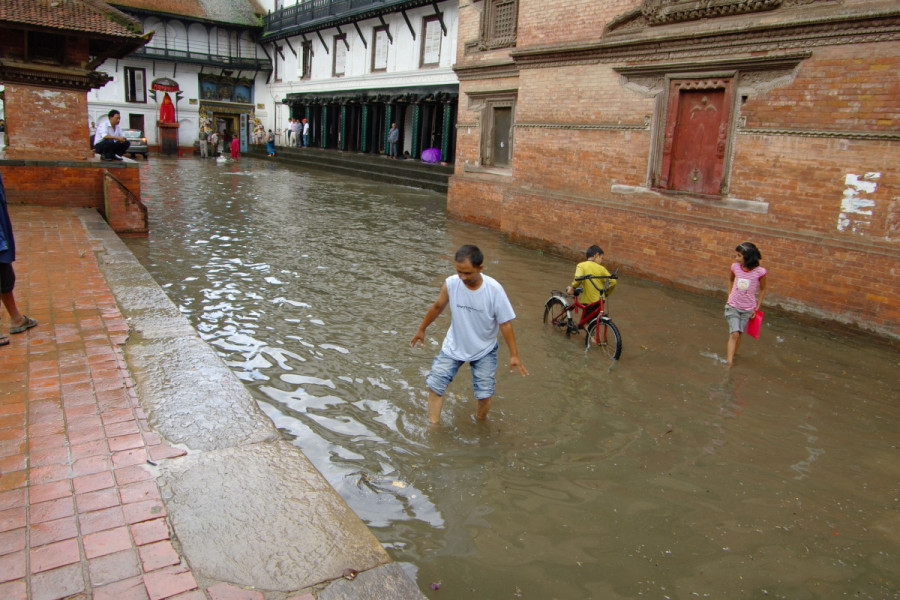Columns
Understanding urban floods
We are at a stage where devastating floods could radically change Kathmandu’s well-being.
Anustha Shrestha
Last month, a young boy aged 13, while going out to play with his friends, drowned in the Samakhusi brook in Kathmandu Valley. The heavy monsoon rainfall had swollen the river, and the nearby roads were waterlogged, making it difficult for the boy to navigate his path. In 2017, a 14-year-old girl was sucked into an open drain in Samakhusi Chowk but luckily emerged on the other end and was rescued. These are just a couple of examples of the impact of urban floods in the Valley, where casualty and economic damage are common.
Nepal receives 80 percent of rainfall in the monsoon season on average, which occurs between mid-June to mid-September. Monsoon, therefore, is also the time of increasing flood events. According to the Nepal government’s Disaster Risk Reduction Portal, 23 people have lost their lives, 336 families have been affected, and the estimated loss from flood damage is more than Rs137 million in the Valley since 2011. These are only the official figures, and many events may likely have remained undocumented. The rivers in the Valley swell up during monsoon and often flood nearby areas, which was also common in the past. However, the flood that occurred centuries ago is different from now.
The key reason for the changing nature of the floods is unplanned urbanisation with haphazard constructions. The Valley is one of the fastest-growing regions in South Asia, where the population has increased by almost 4.8 times since 1971 and reached more than 2.9 million in 2021 (Kathmandu, Lalitpur and Bhaktapur combined). The Valley’s urban areas have grown by 412 percent since 1989, and built-up areas have increased significantly from 2,153ha in 1989 to 15,620ha in 2019. This reflects the decrease in open spaces and the growth of physical infrastructures.
Causes of floods
In the past, the Valley’s soil and sand worked like a sponge, soaking up water and gradually releasing it throughout the year. This helped slow down monsoon floods, minimise damages and prevent rivers from drying up in dry seasons. Now, with the rise in the population, there is a greater demand for infrastructure such as roads, parking spaces and concrete structures. Open spaces and wetlands are decreasing, and the ground surface is becoming impenetrable. As such, water cannot easily seep below the ground, resulting in urban flooding. When the runoff water exceeds Kathmandu’s installed drainage capacity and infiltration rate, the accumulated roadside wastes often block the drainage leading to inundation of the areas. It is also affecting the groundwater recharge of the Valley and further worsening the water security.
Moreover, river encroachment, such as sand mining and building of infrastructures near river bodies, alter the nature of rivers. In addition, bulldozing of sandy hillocks for land plotting and sand has increased in the peri-urban areas of Kathmandu Valley. Therefore, we are losing sand hillocks that could store rainwater and prevent runoff.
Climate change and floods
Studies have suggested that urban floods will become more intense with the impacts of climate change. One such research has pointed out that in the Valley, urban flooding will increase by 40 percent, considering the present and future climate for a 25-year return period. Even the current drainage structures will not be suitable for future climate conditions. The floods and inundation brought by erratic and intense rainfall will affect energy systems, food security, water supply, mobility and communication, disrupting the lives of urban residents.
The impacts of climate change on one sector could affect another, resulting in cascading consequences. For example, the transport of food and medical supplies may be halted if flooding damages the road system, which could harm people's health and nutrition. Unhygienic conditions at the time of floods could cause skin rashes, diarrhoea, typhoid and various gastrointestinal infections. Traffic accidents on flooded roads, for instance, are rarely acknowledged and instead viewed as fleeting incidents.
The United Nations has projected that 68 percent of the world population will live in urban areas by 2050. This means that the impacts of climate change and climate-related disasters such as floods will become more pronounced in the urban areas, with more casualties and economic losses. These floods will mostly affect children, pregnant women, the disabled, elderly people, and the poor, the groups that are more vulnerable and less resilient.
Way forward
How are we to reduce urban flooding impacts and improve the Valley's resilience? The first thing to do is to acknowledge the connection between unplanned urbanisation and the changing nature of floods. Therefore, developing proper land use plans is necessary to prevent haphazard construction. The Valley’s drainage systems require major upgrading and expansion to accommodate and manage heavy rainfall. Likewise, it is critical to manage roadside waste properly to prevent drainage clogging. Developers must prioritise constructing resilient infrastructure that also supports rainwater storage and seepage and reduces runoff. They should also develop adequate plans to protect green spaces and prevent encroachment of rivers and hillocks.
Furthermore, municipalities could engage universities and research institutions to map the flood hazard zones and conduct vulnerability assessments to identify the most vulnerable groups or families in the municipality. It is also pertinent to establish a flood early warning system and preparedness plan with the engagement of communities. Local clubs and civil society organisations could make the public aware of flood response, safety, and protection of valuables.
Since we are now a federal country, we need a paradigm shift in the way our governance functions. The provincial governments must focus on creating opportunities and improving facilities in their respective provinces to retain the population in their regions. This is essential, as the Valley is now at a critical stage where constant pressure could invite deadly disasters, which could radically change the wellbeing of the city. It’s high time we learnt lessons from the recent events and take appropriate measures to protect the Valley and its citizens.




 15.12°C Kathmandu
15.12°C Kathmandu













%20(1).jpg&w=300&height=200)

